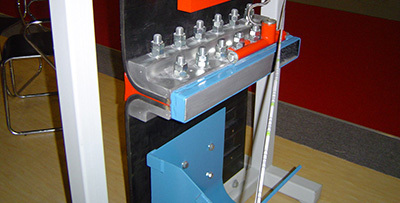News Center
Hezi technology focuses on the research and development of "rapid seamless conveyor belt joint sleeve" innovative technology project

NEWS CENTER

News Details
How to Choose the Right Fasteners for Your Rubber Conveyor Belt
Release time:
2025-06-13
How to Choose the Right Fasteners for Your Rubber Conveyor Belt Table of Contents Understanding Fasteners in Rubber Conveyor Belts Types of Fasteners for Rubber Conveyor Belts Material Selection for Fasteners Installation Techniques for Fasteners Maintenance Tips for Rubber Conveyor Belt Fasteners Safety Considerations When Using Fasteners Common Issues with Conveyor Belt Fasteners
How to Choose the Right Fasteners for Your Rubber Conveyor Belt
Table of Contents
- Understanding Fasteners in Rubber Conveyor Belts
- Types of Fasteners for Rubber Conveyor Belts
- Material Selection for Fasteners
- Installation Techniques for Fasteners
- Maintenance Tips for Rubber Conveyor Belt Fasteners
- Safety Considerations When Using Fasteners
- Common Issues with Conveyor Belt Fasteners
- FAQs about Fasteners for Rubber Conveyor Belts
- Conclusion
Understanding Fasteners in Rubber Conveyor Belts
Fasteners play a crucial role in the functionality and efficiency of rubber conveyor belts. They are essentially the connectors that secure the belt to systems, ensuring that it operates smoothly and effectively. The choice of fasteners can significantly affect the belt's performance, maintenance needs, and overall durability. Selecting the right type of fastener is essential for optimizing your conveyor belt's operation, especially in demanding environments like the chemical and rubber manufacturing industries.
Types of Fasteners for Rubber Conveyor Belts
When it comes to rubber conveyor belts, there are several types of fasteners available, each designed for specific applications. Understanding the differences can help you make an informed decision based on your needs.
Mechanical Fasteners
Mechanical fasteners are one of the most common types used in rubber conveyor belts. These include:
- Clamp Style Fasteners: These are easy to install and adjust. They provide a secure grip and are ideal for quick repairs.
- Hinge Fasteners: Suitable for belts that require flexibility, hinge fasteners allow for easy belt replacement and maintenance.
- Bolt and Nut Fasteners: These offer a robust connection and are ideal for heavy-duty applications.
Vulcanized Fasteners
Vulcanized fasteners are bonded directly to the rubber material. They offer a seamless connection, which minimizes the risk of wear and tear. This type of fastener is particularly beneficial in high-stress environments where flexibility and strength are crucial.
Material Selection for Fasteners
The material of the fasteners is just as important as the type. Choosing the right material ensures durability and corrosion resistance, especially in harsh environments. The most commonly used materials include:
Steel
Steel fasteners offer excellent strength and durability. They are suitable for most applications but may require protective coatings to prevent rust, particularly in humid or corrosive environments.
Stainless Steel
Stainless steel fasteners resist corrosion and are ideal for food processing or chemical applications where exposure to moisture is an issue. They offer longevity and are a wise investment for high-maintenance environments.
Plastic and Composite Materials
Plastic and composite fasteners are lightweight and resist corrosion. While they may not provide the same strength as metal options, they are suitable for light-duty applications and situations where weight is a concern.
Installation Techniques for Fasteners
The installation process is critical to ensuring the effectiveness of fasteners. Follow these guidelines for proper installation:
Prepare the Belt
Before installing fasteners, ensure the rubber conveyor belt is clean and free of debris. This step is crucial for creating a secure connection.
Follow Manufacturer Instructions
Always adhere to the manufacturer's guidelines for installing fasteners. Each type may have specific requirements, and following these can prevent premature failure.
Use the Right Tools
Utilize the appropriate tools for installation to ensure that fasteners are secured properly. This includes using drills, wrenches, or specialty tools recommended for the fasteners you have chosen.
Maintenance Tips for Rubber Conveyor Belt Fasteners
Regular maintenance is essential for prolonging the life of your rubber conveyor belt and its fasteners. Here are some best practices:
Routine Inspections
Conduct regular inspections of the fasteners and the overall belt. Look for signs of wear, rust, or loosening. Early detection can save significant costs in repairs and replacements.
Tighten Fasteners Periodically
Fasteners can loosen over time due to vibrations and stress. Regularly check and tighten them to maintain a secure connection.
Replace Worn Fasteners Immediately
If you notice any wear or damage to fasteners, replace them immediately. Delaying replacement can lead to more significant issues down the line, including belt failure.
Safety Considerations When Using Fasteners
Safety should always be a priority in any industrial environment. Here are some safety considerations when dealing with rubber conveyor belt fasteners:
Follow Safety Guidelines
Always comply with safety guidelines established by your organization or industry standards. This includes wearing appropriate personal protective equipment (PPE) during installation and maintenance.
Be Aware of Moving Parts
Conveyor belts are often in motion, posing risks to workers. Ensure that all safety measures are in place before initiating installation or maintenance tasks.
Common Issues with Conveyor Belt Fasteners
Despite best efforts, issues can arise with conveyor belt fasteners. Understanding common problems can help you address them swiftly:
Corrosion
Corrosion can weaken fasteners and lead to failure. Regular inspections and using the right materials can minimize this risk.
Misalignment
Improper alignment during installation can lead to uneven wear and eventual belt failure. Always ensure precise alignment for optimal performance.
Loosening Over Time
Fasteners may loosen due to vibrations. Regular maintenance checks can help avoid unexpected failures.
FAQs about Fasteners for Rubber Conveyor Belts
What are the most common types of fasteners used for rubber conveyor belts?
The most common fasteners include clamp style, hinge, bolt and nut fasteners, and vulcanized fasteners.
How can I tell if my fasteners are worn out?
Look for signs of corrosion, deformation, or looseness. If you notice any of these signs, it's time to replace your fasteners.
What materials are best for fasteners in high-humidity environments?
Stainless steel and plastic fasteners are ideal for high-humidity environments due to their corrosion resistance.
How often should I inspect my conveyor belt fasteners?
It is recommended to conduct inspections at least once a month or more frequently in high-use environments.
What is the benefit of using vulcanized fasteners?
Vulcanized fasteners provide a seamless bond with the rubber material, which minimizes wear and enhances flexibility.
Conclusion
Choosing the right fasteners for your rubber conveyor belt is a critical task that directly impacts efficiency, durability, and safety in your operations. Understanding the different types, materials, and installation techniques empowers you to make informed decisions tailored to your specific needs. By prioritizing regular maintenance and adhering to safety protocols, you can ensure a smooth-running conveyor system that serves your chemical and rubber production needs effectively. With careful consideration and proactive measures, your conveyor belts can operate at peak performance, securing your success in the industry.

Recommend News





























